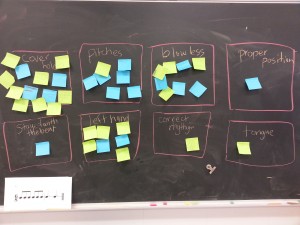Allowing students to have input on criteria for an assignment helps them gain a clearer picture in their mind of what they need to do in order to be successful at a task. Although creating criteria together for every task would be ideal, time usually plays a large factor in making this difficult, especially for planning time teachers. As a planning time teacher, you often see the students for around 30-40 minutes at a time once or twice a week.
Today I want to show you a very quick way (under five minutes) to create criteria with students.
My grade four classes are currently studying the recorder. They are about three weeks into learning this instrument and are now learning a few songs to present next month. In preparation for the assessment and evaluation for their upcoming songs, I wanted them to help create the criteria. I handed out a sticky note to every student when they entered the class. Their job was to write down one thing that they think a person would need to do to be successful at playing a song on the recorder. After about two minutes, I had some students start to share their ideas with the class and we started to listen for some patterns and began to categorize their ideas. Students had active discussions and came up with eight different criteria that they should be assessed on at this point in their learning. The criteria will change as we learn new pieces of music and gain confidence with our basic skills.
The students will all have a copy of the criteria in their duo tangs and I will give them feedback regularly on this sheet as we are working towards improving our skills.
Taking five minutes to create some assessment categories not only gave them a set of very specific skills required to be successful, but also gave me a lot of information. As you can see from the picture below, the amount of students who wrote “cover the holes”, “blow less”, “finger or play the pitches correctly”, “put the left hand on top” far outweighed tonguing or correct rhythm. I can use this information for planning my upcoming mini lessons.
In addition, over the next couple of weeks, I will also be using two or three minutes per class where one student gets to be the teacher and we will practice assessing each other using the criteria. I will play some pieces on the recorder and have the pretend teacher give me some very specific feedback according to the criteria. In just a few classes, the students’ ability to give feedback to each other will drastically improve and this will create an environment where there are multiple experts in the class and everyone can help each other.
Overheard in my Ontario Classroom…
As my family comes from the province of Prince Edward Island, I grew up participating in kitchen parties. I have been inviting my grade five students to participate in kitchen parties with me including some very rowdy versions of I’se the B’y. To demonstrate a true kitchen party, I have been using spoons, foot stomping, piano, pots and pans and basically anything I can to make the songs lively. I was singing joyfully the other day and instead of singing “I’se the B’y that builds the boat”. I sang “I’se the B’y that kills the boat.” Some of the students paused what they were doing with confused looks on their faces and finally one boy raised his hand and asked “Miss. Gallant, do you have something against this boat?” I had no idea I had even sang those lyrics.
Sometimes students are paying closer attention than you are.

